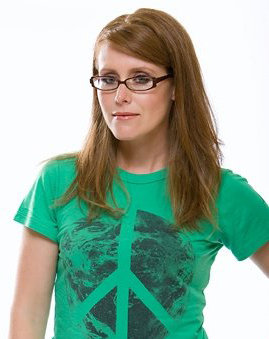
Aysia Wright, Founder of Greenloop
“Dipping into the waste stream. That’s what excites me.”
These are the words spoken by a true eco-pioneer, Aysia Wright, founder ofGreenloop- a Portland based retail and ecommerce resource for sustainable fashion. Why fashion? Well, because this Environmental Policy lawyer and longtime activist thinks fashion is an ideal vehicle to have a conversation with people and to create a platform for change, with natural market forces driving a shift towards sustainability.
Back in the day, Aysia was a Birkenstock-wearing, animal rights spouting environmental progressive who pursued higher education and practiced law in an unrelated field until realizing at age 30 that she’d lost touch with her advocacy roots. So, in 2004, she opened up Greenloop to fill a hole in the market and create a retail solution for finding trend right, fashion forward sustainable clothing. Today, Greenloophas a booming ecommerce division and is opening up a new storefront in downtown Portland, occupying the “closet” space of a new eco-friendly resource concept store under the Seven Planet umbrella.
Over an hour of conversation, Aysia set about debunking trendy misconceptions about sustainable fashion, defining the ultimate importance of the triple bottom line, and painting a picture of the sustainable movement that solidifies it as the hippest and most essential issue since civil rights. Her story as follows…
LJ: Describe the retail environment when Greenloop began operating in 2004 and tell us how it’s changed since.
AW:In this fast fashion culture that we live in, there’s too many garments that just go straight to the landfill. Right now, there’s more of a generalized awareness of what it means for a garment to be certified organic cotton, as opposed to your milk or your bread or your vegetables. When we first opened doors, so many consumers were asking “How could that be organic? That doesn’t make any sense.” and that was really because there was a misconception about what is organic in the first place.
In general, there’s more understanding now of the options available and an awareness that there is a difference between sustainably and ethically produced fashion and and conventional fashion, there’s a growing acceptance that we need to be more conscious in terms of our decisions and voting with our dollar.
In terms of design, about two years ago there was a pretty solid upswing in the availability of quality textiles and solid design getting together to produce designs that could actually survive in the mainstream fashion scene. Whereas initially it was either very yoga-pilates centered or it was environmentalists designing apparel as opposed to designers designing environmentally responsible apparel. So now you’ve got both and they’re learning from each other so you’re seeing quality product coming from both arenas now.
Really, [this progress shows that sustainability is] not a dead movement, it’s not a trend. It’s something that’s becoming more deeply entrenched within the fashion community itself.
LJ: So, over the years, organics have really grown in the food industry and the fashion industry. What do you think will be the next big thing to evolve as the movement grows?
AW: We’ve seen a lot of innovative use by designers dipping into the waste stream, looking at dead stock or getting creative with waste materials that otherwise might have gone straight into the landfill. And I think we’re going to see more of a sophistication of that model as opposed to seeing more one-off, crafty, I made this in my basement type pieces. I think that there will be a more professional application to that, that people are getting wiser about making recycled goods a larger part of the commodities market, to make that process more efficient.
There’s probably going to be a pretty strong emphasis on rebuilding the recycled commodity market because ultimately, it’s a time and resource saver both in terms of raw commodity, reducing strain on natural resources, reducing pressure on landfills, on reducing water and energy inputs, and there’s a great story to it. People love the fact that something has been reincarnated into another product and you can’t really tell.
LJ: The movement for sustainability is really growing and evolving new technologies and efficiencies. What kind of role have you seen yourself and Greenloop take in educating consumers and increasing awareness about sustainability?
AW: I really see Greenloop’s role growing in the advocacy piece for designers, we really are working to develop a platform so that people wanting to get into the sustainable design arena can come to us to source their textiles, to find out which manufacturing facility in the United States they should work with, to find out which distributor they should work with, to facilitate their wholesales. There are a ton of creative people out there that have the skills and the passion and the talent to create a successful line, but it’s a huge endeavor to put all of those pieces into place, so that’s where I see us going in the future.
LJ: The idea of being sustainable is permeating a huge range of industries and markets right now, do you see this growth as a social movement, and industrial shift, or both?
AW: I see it as a social movement but I also do see companies understanding the concept of corporate social responsibility when it comes to their bottom line and really trying to embrace this notion of a triple bottom line (People, Planet, and Profit) because there are some real limitations to operating business as usual. This linear system that sprang up at the beginning of the industrial revolution is this constant input of energy, both human and fossil fuel based, and natural resources along a system that ends up in the dump. It’s not a closed loop, it doesn’t recapture any lost energy and it creates harm along the way to people and planet.
The companies that are going to be ahead of the curve are looking at how they can increase their profitability by becoming more energy efficient, using less resources, embracing recycled products. They will naturally realize that economic success and ecological responsibility are not counter intuitive, they are actually very much interrelated.
LJ:Tell me a little more about the community aspect of sustainability as a social movement.
AW: I’ve talked to a lot of people in the conventional fashion industry that got out because it was just an ugly scene for them. It was very cutthroat with no sharing of resources or information, whereas my experience has been that this community is mission oriented. And, when something is mission oriented for the greater good, while also providing you with a living along the way, that there is just more incentive to make sure that everyone is successful. For example, Greenloop can’t be the only eco-retailer- no eco-designer would survive if that was the case. So it’s in my best interest to hopefully support all the other eco-retailers that I would typically consider my competition. It’s in designers’ best interest to share their resources so they can ultimately reach an economy of scale and make their whole production processes more efficient, so that each one of them survives to retain and gain a piece of the market. So from that perspective, I think that there is definitely a distinction that makes this social movement, this collaboration, unique and inspiring because it feels good to talk to people and work with people who are working towards the same ends as you, and it’s not just a selfish ends.
LJ: Today there is an emphasis in collaboration and community within the movement. How do you see the youth shaping the growth and development of sustainability in the future?
AW: Well, the Greenloop platform, Project Green Search is our way of communicating the message that it is possible and it’s beneficial to align your career choices with your environmental, social, humanitarian ethics, whatever cause inspires you. I think it’s possible to create this next generation of young people in the workforce who hopefully can refuse to go to work for companies they don’t believe in because they are going to bring their skills to grow companies that are doing the right thing. I think that there’s been a shift in the way that we are educating young people right now so that they are learning from a very early age that they are global citizens, and that we’re providing them with the knowledge and hopefully the desire and the drive to contribute to something that is greater than just themselves and their piece of the pie. And, I think we’re seeing a lot of that in terms of teen participation and fundraising and outreach efforts, like the organization Teens Turning Green, that are reaching out to teenagers on a variety of issues like Teens for Safe Cosmetics or Buying Sustainable Fashion for Prom, or Greening Dorm Rooms who are working with Greenloop on Project Green Search. I think the opportunity lies in that we are going to hopefully develop this entire generation of young people who don’t have to break habits like we do.
LJ: Speaking of bad habits, do you think the current patterns of consumerism are going to change, along with the notion that “more is better?”
AW: I do, but I think it’s going to take a while because it’s really going to require a societal shift in terms of what constitutes success. A lot of people attribute material wealth and acquisition to be success, and that definition of success to happiness and it’s a very Western first-world, developed-nation ideal, and it’s going to take a while to move away from that so that people start developing themselves and their happiness and their definition of success in other areas. Some of that is going to be enforced or imposed because we’ve already got more people on this planet than we can support, and we’re already using three quarters of the world’s natural resources, and that’s inherently unsustainable. If society is able to adopt this concept of quality over quantity and we don’t need to live in a 3,000 square foot house and we can live instead in a 1,000 square foot house, it will be a grassroots movement with parents hopefully instilling these ideals into their kids because ultimately, that’s where it starts.
LJ: What do you predict will be the movement’s biggest obstacle in reaching that kind of societal shift?”
AW: The use of the media. We’re seeing a pretty drastic change in media right now, especially in printed media. A lot of magazines are going under, and I think with them hopefully you’ll lose some of this driving force behind the consumption machine. I think that the speed of news right now will help, with the accessibility of news and information on the internet, especially information from sources that aren’t well funded, that can articulate and present this different lifestyle concept is more readily available to people than just picking up your mainstream magazine off the rack. I went to the Sundance Film Festival and saw the Inconvenient Truth when it debuted, and I think that film was a tipping point, quite frankly, and a very poignant example of how powerful media can be when used in that capacity.
LJ: Can you tell us about some unique or unusual materials that are up and coming in the sustainable fashion industry?
AW: You know, I don’t think it’s about being unique at this point. I get that question a lot, like “What’s the new sustainable textile?”, and for instance, bamboo, is a great example of something that is new that is not necessarily better. I think it’s about taking a look at textiles like hemp, for example, which has gotten this horrible wrap for years and years and years but there are some amazing fabrications now using hemp that you would not believe in terms of its strength and hand and luster and quality. So I don’t think it necessarily has to be this new technology or complicated advancement, you know you have other designers going for this very sort of high-tech “what are you talking about fabrics?” made out of milk or made out of seaweed and you know, that’s buzz. I’m trying to stay away from the buzz factor, making sure that you hone in on those textiles that over the long haul are going to hold up. And they can still be beautiful and sexy and trendy, but they don’t have to have all the buzz attached to them. I think it’s being wary of anything that’s new and cutting edge, when it comes to textile production that is not yet tested, and that doesn’t have a transparent process because it’s not necessarily better.
LJ: So buzz or no buzz, I’m sure we’ll be seeing a plethora of sustainable fabrics on the runway this year in Portland’s Fashion Week. Tell us a little more about Project Green Search.
AW: This year at Portland Fashion Week, we are working to concentrate all the eco-designers for a Sunday night event, on October 11th. And Greenloop is hosting a green model search, called Project Green Search which is part of a greater movement to get people to think about aligning their careers with their environmental and social ethics. And a model competition is a natural expression of that’s because a model is sort of a tangible representative of the company they are working for. It’s launching on Friday, August 7, 2009, and it’s open to women age 17 and older. There’s a lot of talent out there that’s more than skin deep, so each model has to submit an essay, a video and volunteer for an environmental organization in their area and share their experiences, so she’s not just going to be a hanger.
The point is to really light that spark for people so that they think, “Wow, I have these skills and this passion and I don’t have to go and work for XYZ coal mining company, I can support another company.” I think there’s this huge opportunity we have in the midst of this recession to reshape our landscape, both in terms of the job talent pool and the companies that are going to come out of this and be successful.”
The Project Greensearch finale will coincide with Portland Fashion Week, dubbed the “Greenest Fashion Week in the World” where sustainable fashion brands will bring the week to a close in an eco-event on Sunday. Follow the competition, and stay in the loop with GreenLoop on their blog.













